NURS 3001 Case Study: Critical Analysis of Bleeding Post-Angioplasty
VerifiedAdded on 2023/06/11
|10
|2559
|67
Case Study
AI Summary
This case study critically analyzes the potential problem of bleeding complications in a 78-year-old patient, Mrs. Elizabeth Green, following coronary angioplasty via the femoral artery approach. It provides a rationale for choosing bleeding as the primary concern, discussing the anatomical and physiological factors, pathophysiology, and pharmacological considerations that contribute to this risk, particularly in elderly patients. The analysis explores the implications of bleeding, including increased hospital stay, mortality, and other complications. A detailed plan of care is presented, focusing on risk assessment, puncture site monitoring, medication management (anti-platelet and anti-coagulant agents), and the use of closure devices. Post-discharge education is emphasized to prevent further complications. The care plan's effectiveness in identifying and mitigating bleeding risks is evaluated in relation to the NMBA Registered Nurse Standards for Practice, specifically Standard 7, highlighting the importance of outcome evaluation to inform nursing practice. This document is available on Desklib, a platform offering a wide range of study resources for students.

Running head: CRITICAL ANALYSIS
Critical analysis
Name of the student:
Name of the University:
Author’s note
Critical analysis
Name of the student:
Name of the University:
Author’s note
Paraphrase This Document
Need a fresh take? Get an instant paraphrase of this document with our AI Paraphraser
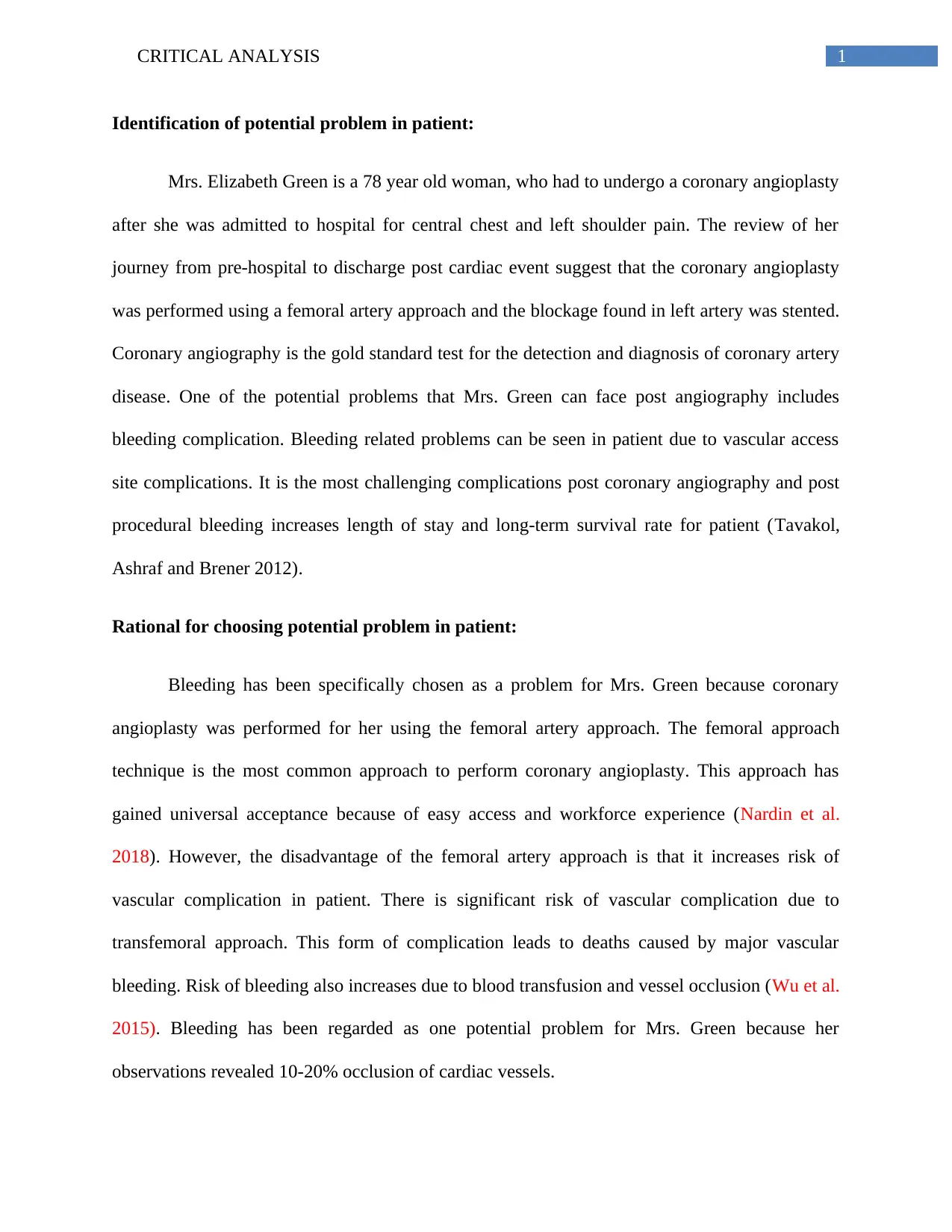
1CRITICAL ANALYSIS
Identification of potential problem in patient:
Mrs. Elizabeth Green is a 78 year old woman, who had to undergo a coronary angioplasty
after she was admitted to hospital for central chest and left shoulder pain. The review of her
journey from pre-hospital to discharge post cardiac event suggest that the coronary angioplasty
was performed using a femoral artery approach and the blockage found in left artery was stented.
Coronary angiography is the gold standard test for the detection and diagnosis of coronary artery
disease. One of the potential problems that Mrs. Green can face post angiography includes
bleeding complication. Bleeding related problems can be seen in patient due to vascular access
site complications. It is the most challenging complications post coronary angiography and post
procedural bleeding increases length of stay and long-term survival rate for patient (Tavakol,
Ashraf and Brener 2012).
Rational for choosing potential problem in patient:
Bleeding has been specifically chosen as a problem for Mrs. Green because coronary
angioplasty was performed for her using the femoral artery approach. The femoral approach
technique is the most common approach to perform coronary angioplasty. This approach has
gained universal acceptance because of easy access and workforce experience (Nardin et al.
2018). However, the disadvantage of the femoral artery approach is that it increases risk of
vascular complication in patient. There is significant risk of vascular complication due to
transfemoral approach. This form of complication leads to deaths caused by major vascular
bleeding. Risk of bleeding also increases due to blood transfusion and vessel occlusion (Wu et al.
2015). Bleeding has been regarded as one potential problem for Mrs. Green because her
observations revealed 10-20% occlusion of cardiac vessels.
Identification of potential problem in patient:
Mrs. Elizabeth Green is a 78 year old woman, who had to undergo a coronary angioplasty
after she was admitted to hospital for central chest and left shoulder pain. The review of her
journey from pre-hospital to discharge post cardiac event suggest that the coronary angioplasty
was performed using a femoral artery approach and the blockage found in left artery was stented.
Coronary angiography is the gold standard test for the detection and diagnosis of coronary artery
disease. One of the potential problems that Mrs. Green can face post angiography includes
bleeding complication. Bleeding related problems can be seen in patient due to vascular access
site complications. It is the most challenging complications post coronary angiography and post
procedural bleeding increases length of stay and long-term survival rate for patient (Tavakol,
Ashraf and Brener 2012).
Rational for choosing potential problem in patient:
Bleeding has been specifically chosen as a problem for Mrs. Green because coronary
angioplasty was performed for her using the femoral artery approach. The femoral approach
technique is the most common approach to perform coronary angioplasty. This approach has
gained universal acceptance because of easy access and workforce experience (Nardin et al.
2018). However, the disadvantage of the femoral artery approach is that it increases risk of
vascular complication in patient. There is significant risk of vascular complication due to
transfemoral approach. This form of complication leads to deaths caused by major vascular
bleeding. Risk of bleeding also increases due to blood transfusion and vessel occlusion (Wu et al.
2015). Bleeding has been regarded as one potential problem for Mrs. Green because her
observations revealed 10-20% occlusion of cardiac vessels.
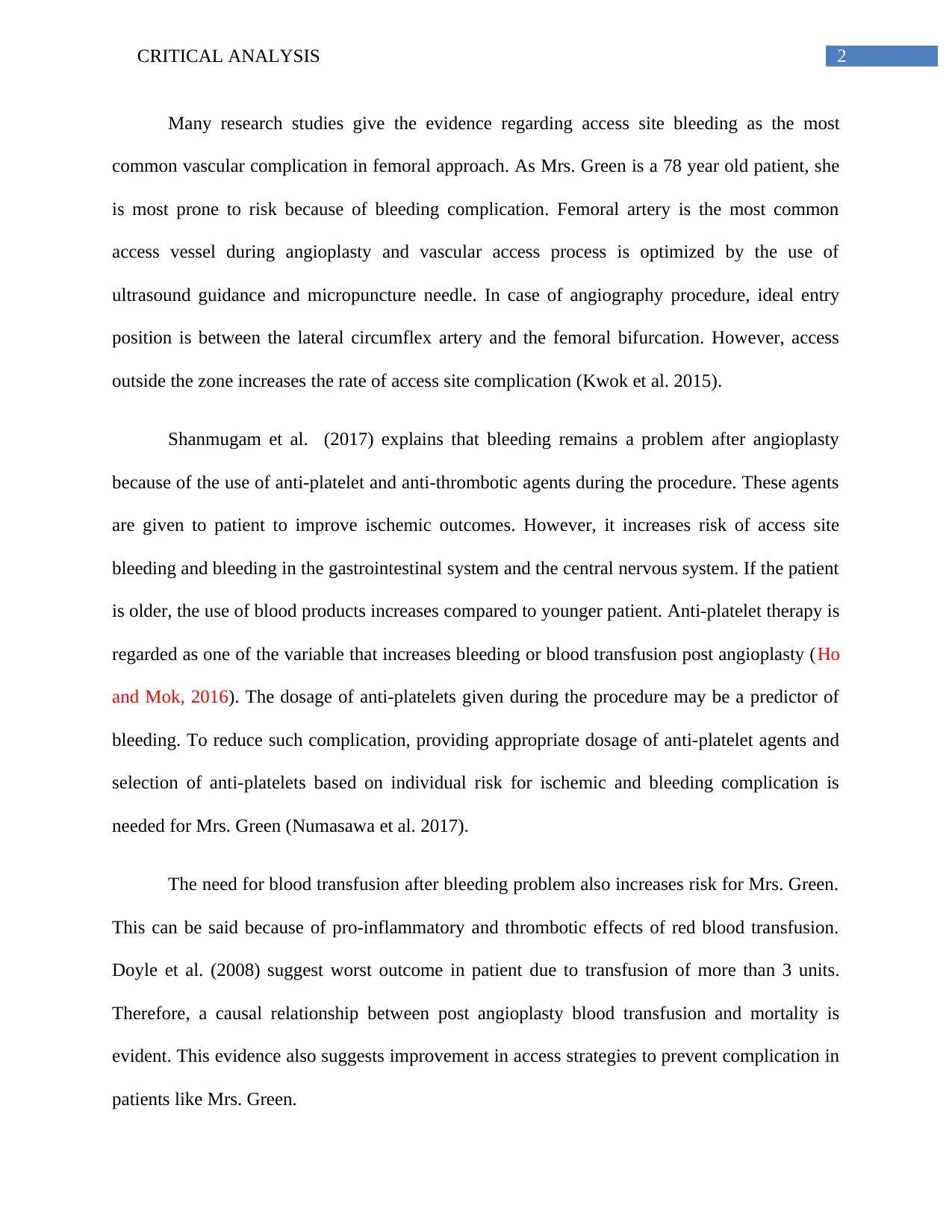
2CRITICAL ANALYSIS
Many research studies give the evidence regarding access site bleeding as the most
common vascular complication in femoral approach. As Mrs. Green is a 78 year old patient, she
is most prone to risk because of bleeding complication. Femoral artery is the most common
access vessel during angioplasty and vascular access process is optimized by the use of
ultrasound guidance and micropuncture needle. In case of angiography procedure, ideal entry
position is between the lateral circumflex artery and the femoral bifurcation. However, access
outside the zone increases the rate of access site complication (Kwok et al. 2015).
Shanmugam et al. (2017) explains that bleeding remains a problem after angioplasty
because of the use of anti-platelet and anti-thrombotic agents during the procedure. These agents
are given to patient to improve ischemic outcomes. However, it increases risk of access site
bleeding and bleeding in the gastrointestinal system and the central nervous system. If the patient
is older, the use of blood products increases compared to younger patient. Anti-platelet therapy is
regarded as one of the variable that increases bleeding or blood transfusion post angioplasty (Ho
and Mok, 2016). The dosage of anti-platelets given during the procedure may be a predictor of
bleeding. To reduce such complication, providing appropriate dosage of anti-platelet agents and
selection of anti-platelets based on individual risk for ischemic and bleeding complication is
needed for Mrs. Green (Numasawa et al. 2017).
The need for blood transfusion after bleeding problem also increases risk for Mrs. Green.
This can be said because of pro-inflammatory and thrombotic effects of red blood transfusion.
Doyle et al. (2008) suggest worst outcome in patient due to transfusion of more than 3 units.
Therefore, a causal relationship between post angioplasty blood transfusion and mortality is
evident. This evidence also suggests improvement in access strategies to prevent complication in
patients like Mrs. Green.
Many research studies give the evidence regarding access site bleeding as the most
common vascular complication in femoral approach. As Mrs. Green is a 78 year old patient, she
is most prone to risk because of bleeding complication. Femoral artery is the most common
access vessel during angioplasty and vascular access process is optimized by the use of
ultrasound guidance and micropuncture needle. In case of angiography procedure, ideal entry
position is between the lateral circumflex artery and the femoral bifurcation. However, access
outside the zone increases the rate of access site complication (Kwok et al. 2015).
Shanmugam et al. (2017) explains that bleeding remains a problem after angioplasty
because of the use of anti-platelet and anti-thrombotic agents during the procedure. These agents
are given to patient to improve ischemic outcomes. However, it increases risk of access site
bleeding and bleeding in the gastrointestinal system and the central nervous system. If the patient
is older, the use of blood products increases compared to younger patient. Anti-platelet therapy is
regarded as one of the variable that increases bleeding or blood transfusion post angioplasty (Ho
and Mok, 2016). The dosage of anti-platelets given during the procedure may be a predictor of
bleeding. To reduce such complication, providing appropriate dosage of anti-platelet agents and
selection of anti-platelets based on individual risk for ischemic and bleeding complication is
needed for Mrs. Green (Numasawa et al. 2017).
The need for blood transfusion after bleeding problem also increases risk for Mrs. Green.
This can be said because of pro-inflammatory and thrombotic effects of red blood transfusion.
Doyle et al. (2008) suggest worst outcome in patient due to transfusion of more than 3 units.
Therefore, a causal relationship between post angioplasty blood transfusion and mortality is
evident. This evidence also suggests improvement in access strategies to prevent complication in
patients like Mrs. Green.
⊘ This is a preview!⊘
Do you want full access?
Subscribe today to unlock all pages.

Trusted by 1+ million students worldwide

3CRITICAL ANALYSIS
Implication of the problem for Mrs. Green:
In case of Mrs. Green, bleeding complication may increase length of hospital stay, long-
term mortality and risk of non fatal myocardial infarction and stroke for patient. Major femoral
bleeding complication and blood transfusion can also increase the risk of death by causing severe
comorbidities (Shanmugam et al. 2017). Taking adequate steps for identification of bleeding
complication is also necessary to prevent additional treatment, longer hospital stay and high
health care cost (Bhatty et al. 2011).
Plan of care and rational:
As chances of bleeding may increase co-morbidity and length of hospital for Mrs. Green
post angioplasty, the goal of care is to prevent bleeding and reduce complications and discomfort
for patient. As anti-platelet therapy, access site complication and age of patient has been
regarded as a predictor of bleeding, the need for dosage of certain drugs and preventive measures
for the health and recovery of patient must be considered (Mattea et al. 2017). The rational for
platelet activation, adverse effects of blood transfusion, discontinuation of anti-platelets and
prevalence of co-morbidities should be considered to identify the problem and modify dosage or
schedule of certain treatment for Mr. Green.
The first care plan for patient is to conduct physical assessment of Mrs. Green to identify
individual risk for bleeding complication. It is necessary to obtain all relevant
information related to the history of coronary angioplasty. For example, identification of
patient age and access site such as arterial or venous site during angioplasty is necessary
to understand whether age or procedure related factors increases risk of bleeding for Mrs.
Green. Inquiry should also be done regarding the use of anticoagulants during the
Implication of the problem for Mrs. Green:
In case of Mrs. Green, bleeding complication may increase length of hospital stay, long-
term mortality and risk of non fatal myocardial infarction and stroke for patient. Major femoral
bleeding complication and blood transfusion can also increase the risk of death by causing severe
comorbidities (Shanmugam et al. 2017). Taking adequate steps for identification of bleeding
complication is also necessary to prevent additional treatment, longer hospital stay and high
health care cost (Bhatty et al. 2011).
Plan of care and rational:
As chances of bleeding may increase co-morbidity and length of hospital for Mrs. Green
post angioplasty, the goal of care is to prevent bleeding and reduce complications and discomfort
for patient. As anti-platelet therapy, access site complication and age of patient has been
regarded as a predictor of bleeding, the need for dosage of certain drugs and preventive measures
for the health and recovery of patient must be considered (Mattea et al. 2017). The rational for
platelet activation, adverse effects of blood transfusion, discontinuation of anti-platelets and
prevalence of co-morbidities should be considered to identify the problem and modify dosage or
schedule of certain treatment for Mr. Green.
The first care plan for patient is to conduct physical assessment of Mrs. Green to identify
individual risk for bleeding complication. It is necessary to obtain all relevant
information related to the history of coronary angioplasty. For example, identification of
patient age and access site such as arterial or venous site during angioplasty is necessary
to understand whether age or procedure related factors increases risk of bleeding for Mrs.
Green. Inquiry should also be done regarding the use of anticoagulants during the
Paraphrase This Document
Need a fresh take? Get an instant paraphrase of this document with our AI Paraphraser

4CRITICAL ANALYSIS
angioplasty procedure as this may help to evaluate whether anti-coagulant use can
increase the risk of bleeding post angio or not. Initial assessment of the above mentioned
factors for Mrs. Green will be important to understand the impact of oral anti-coagulants
and anti-platelet therapy for patient. Nathan, Sen and Yeh (2017) suggest that anti-
platelet therapies treat acute thrombosis, however use or continuation of anti-platelet
agents is dependent on bleeding risk.
The next course of action is to conduct puncture site assessment for Mrs. Green and
assess other forms of potential complication in patient. Assessment of puncture site is
necessary to check for signs of bleeding, hematoma and infection near the puncture site.
If bleeding has been found as an issue for Mrs. Green, assessment for presence of signs
like tachycardia, pulse pressure, decrease hemoglobin level, agitation and hypotension
will also be done. These steps will be crucial to identify problems in patient.
As vascular site complication and bleeding occurs because of the use of anti-coagulant
and anti-platelet agents, reviewing and considering the type of anticoagulant agents to be
used for patient will also be necessary. Certain agents like heparin increase risk of
bleeding in patient (Kasapis et al. 2010). Hence, adjusting the dose of heparin or
combining it with other drugs can reduce complication for Mrs. Green.
The use of appropriate closure device can also be considered for Mrs. Green. Arterial
closure device can promote early mobility of patient and improve comfort level for Mrs.
post angiography. It can reduce health care cost and promote early discharge of patient
too (Bhatty et al. 2011)..
To control bleeding, manual compression can be implemented as the first intervention.
However, if this intervention fails, anticoagulant therapy can be discontinued for Mrs
angioplasty procedure as this may help to evaluate whether anti-coagulant use can
increase the risk of bleeding post angio or not. Initial assessment of the above mentioned
factors for Mrs. Green will be important to understand the impact of oral anti-coagulants
and anti-platelet therapy for patient. Nathan, Sen and Yeh (2017) suggest that anti-
platelet therapies treat acute thrombosis, however use or continuation of anti-platelet
agents is dependent on bleeding risk.
The next course of action is to conduct puncture site assessment for Mrs. Green and
assess other forms of potential complication in patient. Assessment of puncture site is
necessary to check for signs of bleeding, hematoma and infection near the puncture site.
If bleeding has been found as an issue for Mrs. Green, assessment for presence of signs
like tachycardia, pulse pressure, decrease hemoglobin level, agitation and hypotension
will also be done. These steps will be crucial to identify problems in patient.
As vascular site complication and bleeding occurs because of the use of anti-coagulant
and anti-platelet agents, reviewing and considering the type of anticoagulant agents to be
used for patient will also be necessary. Certain agents like heparin increase risk of
bleeding in patient (Kasapis et al. 2010). Hence, adjusting the dose of heparin or
combining it with other drugs can reduce complication for Mrs. Green.
The use of appropriate closure device can also be considered for Mrs. Green. Arterial
closure device can promote early mobility of patient and improve comfort level for Mrs.
post angiography. It can reduce health care cost and promote early discharge of patient
too (Bhatty et al. 2011)..
To control bleeding, manual compression can be implemented as the first intervention.
However, if this intervention fails, anticoagulant therapy can be discontinued for Mrs
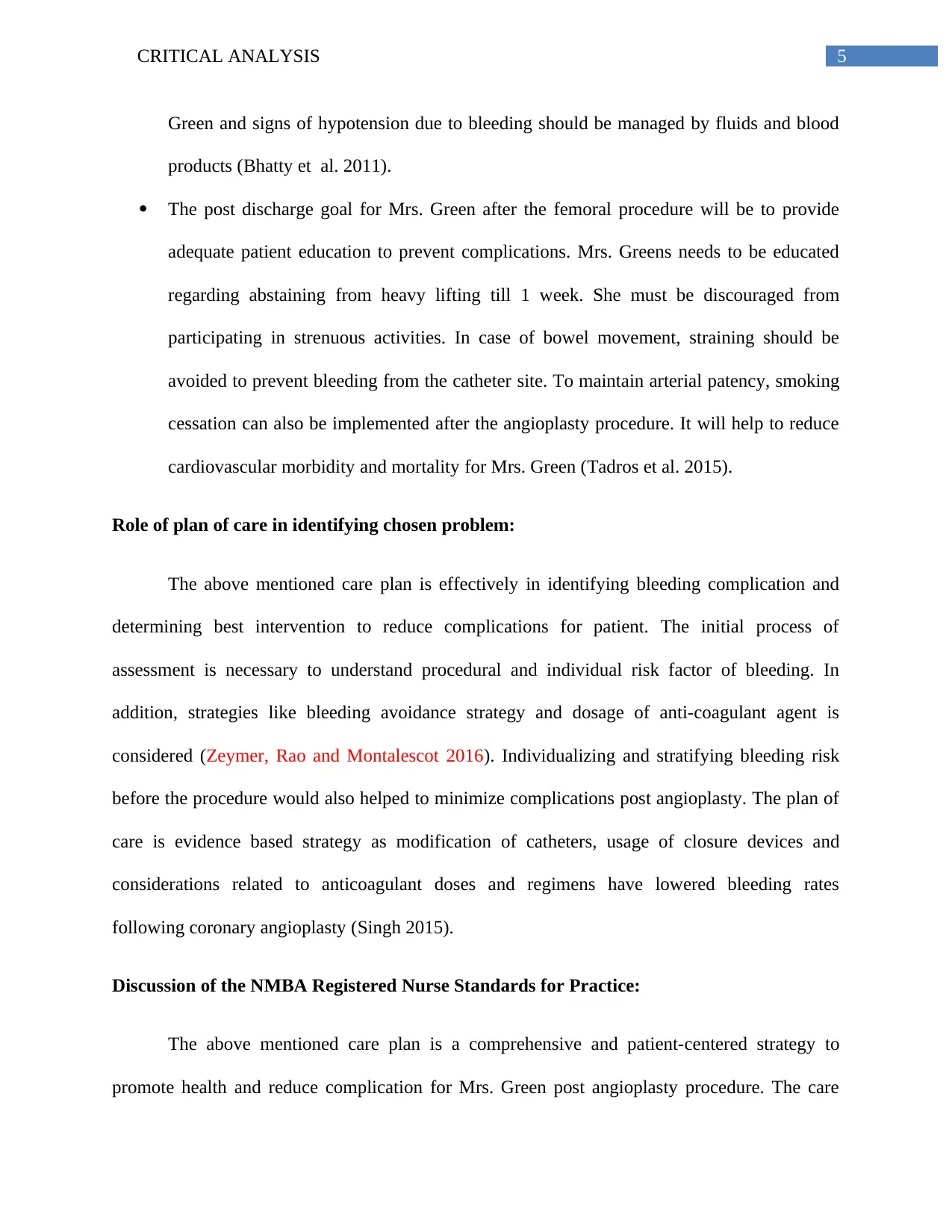
5CRITICAL ANALYSIS
Green and signs of hypotension due to bleeding should be managed by fluids and blood
products (Bhatty et al. 2011).
The post discharge goal for Mrs. Green after the femoral procedure will be to provide
adequate patient education to prevent complications. Mrs. Greens needs to be educated
regarding abstaining from heavy lifting till 1 week. She must be discouraged from
participating in strenuous activities. In case of bowel movement, straining should be
avoided to prevent bleeding from the catheter site. To maintain arterial patency, smoking
cessation can also be implemented after the angioplasty procedure. It will help to reduce
cardiovascular morbidity and mortality for Mrs. Green (Tadros et al. 2015).
Role of plan of care in identifying chosen problem:
The above mentioned care plan is effectively in identifying bleeding complication and
determining best intervention to reduce complications for patient. The initial process of
assessment is necessary to understand procedural and individual risk factor of bleeding. In
addition, strategies like bleeding avoidance strategy and dosage of anti-coagulant agent is
considered (Zeymer, Rao and Montalescot 2016). Individualizing and stratifying bleeding risk
before the procedure would also helped to minimize complications post angioplasty. The plan of
care is evidence based strategy as modification of catheters, usage of closure devices and
considerations related to anticoagulant doses and regimens have lowered bleeding rates
following coronary angioplasty (Singh 2015).
Discussion of the NMBA Registered Nurse Standards for Practice:
The above mentioned care plan is a comprehensive and patient-centered strategy to
promote health and reduce complication for Mrs. Green post angioplasty procedure. The care
Green and signs of hypotension due to bleeding should be managed by fluids and blood
products (Bhatty et al. 2011).
The post discharge goal for Mrs. Green after the femoral procedure will be to provide
adequate patient education to prevent complications. Mrs. Greens needs to be educated
regarding abstaining from heavy lifting till 1 week. She must be discouraged from
participating in strenuous activities. In case of bowel movement, straining should be
avoided to prevent bleeding from the catheter site. To maintain arterial patency, smoking
cessation can also be implemented after the angioplasty procedure. It will help to reduce
cardiovascular morbidity and mortality for Mrs. Green (Tadros et al. 2015).
Role of plan of care in identifying chosen problem:
The above mentioned care plan is effectively in identifying bleeding complication and
determining best intervention to reduce complications for patient. The initial process of
assessment is necessary to understand procedural and individual risk factor of bleeding. In
addition, strategies like bleeding avoidance strategy and dosage of anti-coagulant agent is
considered (Zeymer, Rao and Montalescot 2016). Individualizing and stratifying bleeding risk
before the procedure would also helped to minimize complications post angioplasty. The plan of
care is evidence based strategy as modification of catheters, usage of closure devices and
considerations related to anticoagulant doses and regimens have lowered bleeding rates
following coronary angioplasty (Singh 2015).
Discussion of the NMBA Registered Nurse Standards for Practice:
The above mentioned care plan is a comprehensive and patient-centered strategy to
promote health and reduce complication for Mrs. Green post angioplasty procedure. The care
⊘ This is a preview!⊘
Do you want full access?
Subscribe today to unlock all pages.

Trusted by 1+ million students worldwide
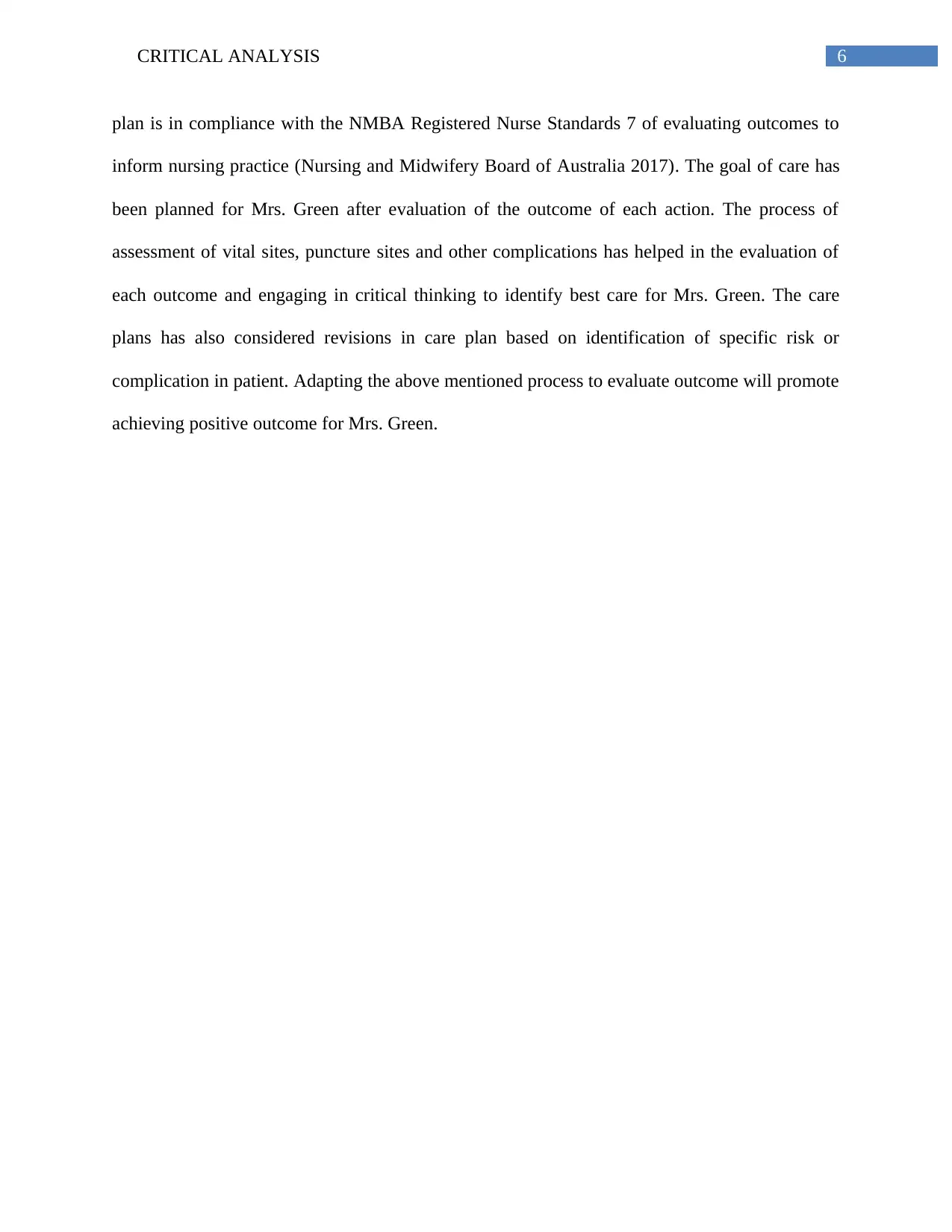
6CRITICAL ANALYSIS
plan is in compliance with the NMBA Registered Nurse Standards 7 of evaluating outcomes to
inform nursing practice (Nursing and Midwifery Board of Australia 2017). The goal of care has
been planned for Mrs. Green after evaluation of the outcome of each action. The process of
assessment of vital sites, puncture sites and other complications has helped in the evaluation of
each outcome and engaging in critical thinking to identify best care for Mrs. Green. The care
plans has also considered revisions in care plan based on identification of specific risk or
complication in patient. Adapting the above mentioned process to evaluate outcome will promote
achieving positive outcome for Mrs. Green.
plan is in compliance with the NMBA Registered Nurse Standards 7 of evaluating outcomes to
inform nursing practice (Nursing and Midwifery Board of Australia 2017). The goal of care has
been planned for Mrs. Green after evaluation of the outcome of each action. The process of
assessment of vital sites, puncture sites and other complications has helped in the evaluation of
each outcome and engaging in critical thinking to identify best care for Mrs. Green. The care
plans has also considered revisions in care plan based on identification of specific risk or
complication in patient. Adapting the above mentioned process to evaluate outcome will promote
achieving positive outcome for Mrs. Green.
Paraphrase This Document
Need a fresh take? Get an instant paraphrase of this document with our AI Paraphraser
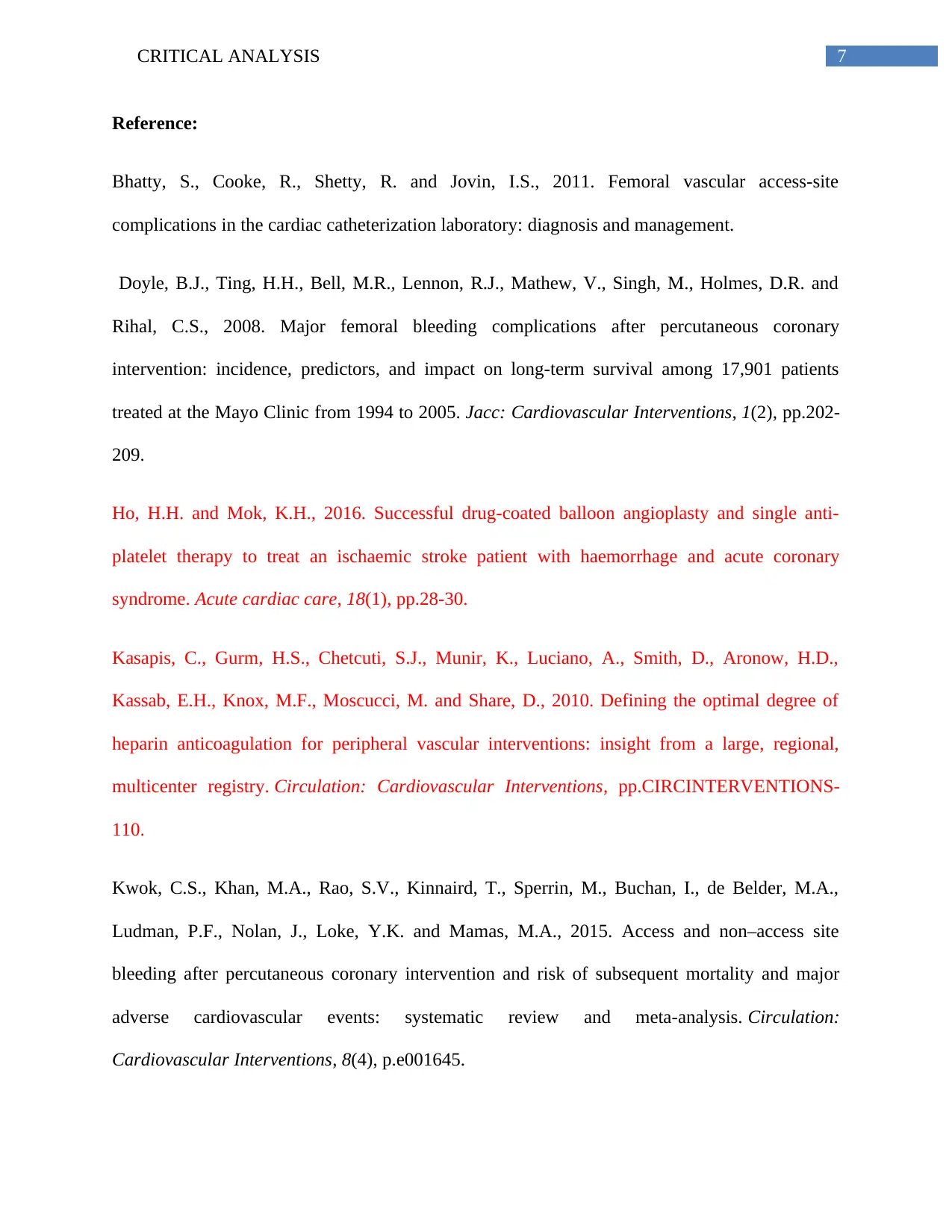
7CRITICAL ANALYSIS
Reference:
Bhatty, S., Cooke, R., Shetty, R. and Jovin, I.S., 2011. Femoral vascular access-site
complications in the cardiac catheterization laboratory: diagnosis and management.
Doyle, B.J., Ting, H.H., Bell, M.R., Lennon, R.J., Mathew, V., Singh, M., Holmes, D.R. and
Rihal, C.S., 2008. Major femoral bleeding complications after percutaneous coronary
intervention: incidence, predictors, and impact on long-term survival among 17,901 patients
treated at the Mayo Clinic from 1994 to 2005. Jacc: Cardiovascular Interventions, 1(2), pp.202-
209.
Ho, H.H. and Mok, K.H., 2016. Successful drug-coated balloon angioplasty and single anti-
platelet therapy to treat an ischaemic stroke patient with haemorrhage and acute coronary
syndrome. Acute cardiac care, 18(1), pp.28-30.
Kasapis, C., Gurm, H.S., Chetcuti, S.J., Munir, K., Luciano, A., Smith, D., Aronow, H.D.,
Kassab, E.H., Knox, M.F., Moscucci, M. and Share, D., 2010. Defining the optimal degree of
heparin anticoagulation for peripheral vascular interventions: insight from a large, regional,
multicenter registry. Circulation: Cardiovascular Interventions, pp.CIRCINTERVENTIONS-
110.
Kwok, C.S., Khan, M.A., Rao, S.V., Kinnaird, T., Sperrin, M., Buchan, I., de Belder, M.A.,
Ludman, P.F., Nolan, J., Loke, Y.K. and Mamas, M.A., 2015. Access and non–access site
bleeding after percutaneous coronary intervention and risk of subsequent mortality and major
adverse cardiovascular events: systematic review and meta-analysis. Circulation:
Cardiovascular Interventions, 8(4), p.e001645.
Reference:
Bhatty, S., Cooke, R., Shetty, R. and Jovin, I.S., 2011. Femoral vascular access-site
complications in the cardiac catheterization laboratory: diagnosis and management.
Doyle, B.J., Ting, H.H., Bell, M.R., Lennon, R.J., Mathew, V., Singh, M., Holmes, D.R. and
Rihal, C.S., 2008. Major femoral bleeding complications after percutaneous coronary
intervention: incidence, predictors, and impact on long-term survival among 17,901 patients
treated at the Mayo Clinic from 1994 to 2005. Jacc: Cardiovascular Interventions, 1(2), pp.202-
209.
Ho, H.H. and Mok, K.H., 2016. Successful drug-coated balloon angioplasty and single anti-
platelet therapy to treat an ischaemic stroke patient with haemorrhage and acute coronary
syndrome. Acute cardiac care, 18(1), pp.28-30.
Kasapis, C., Gurm, H.S., Chetcuti, S.J., Munir, K., Luciano, A., Smith, D., Aronow, H.D.,
Kassab, E.H., Knox, M.F., Moscucci, M. and Share, D., 2010. Defining the optimal degree of
heparin anticoagulation for peripheral vascular interventions: insight from a large, regional,
multicenter registry. Circulation: Cardiovascular Interventions, pp.CIRCINTERVENTIONS-
110.
Kwok, C.S., Khan, M.A., Rao, S.V., Kinnaird, T., Sperrin, M., Buchan, I., de Belder, M.A.,
Ludman, P.F., Nolan, J., Loke, Y.K. and Mamas, M.A., 2015. Access and non–access site
bleeding after percutaneous coronary intervention and risk of subsequent mortality and major
adverse cardiovascular events: systematic review and meta-analysis. Circulation:
Cardiovascular Interventions, 8(4), p.e001645.
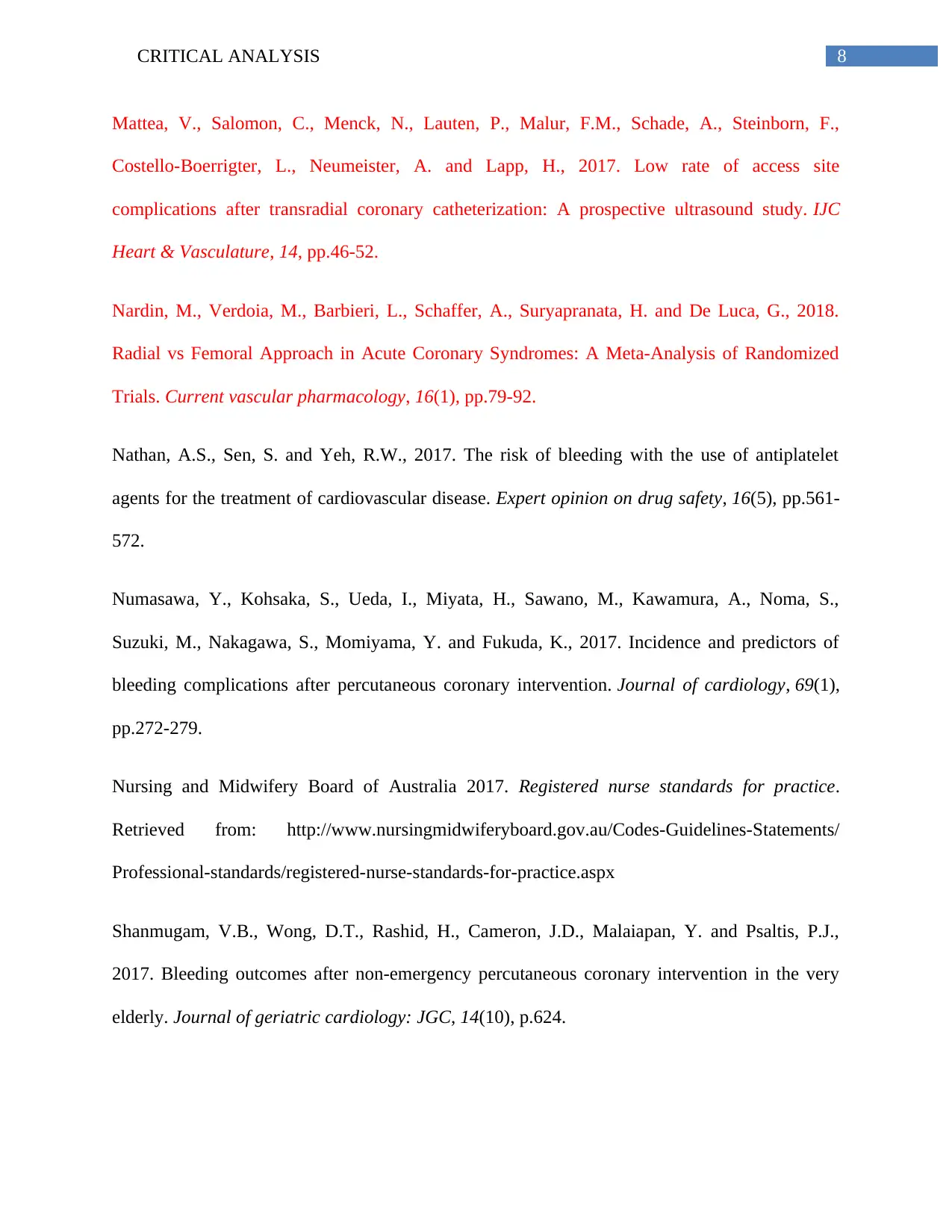
8CRITICAL ANALYSIS
Mattea, V., Salomon, C., Menck, N., Lauten, P., Malur, F.M., Schade, A., Steinborn, F.,
Costello-Boerrigter, L., Neumeister, A. and Lapp, H., 2017. Low rate of access site
complications after transradial coronary catheterization: A prospective ultrasound study. IJC
Heart & Vasculature, 14, pp.46-52.
Nardin, M., Verdoia, M., Barbieri, L., Schaffer, A., Suryapranata, H. and De Luca, G., 2018.
Radial vs Femoral Approach in Acute Coronary Syndromes: A Meta-Analysis of Randomized
Trials. Current vascular pharmacology, 16(1), pp.79-92.
Nathan, A.S., Sen, S. and Yeh, R.W., 2017. The risk of bleeding with the use of antiplatelet
agents for the treatment of cardiovascular disease. Expert opinion on drug safety, 16(5), pp.561-
572.
Numasawa, Y., Kohsaka, S., Ueda, I., Miyata, H., Sawano, M., Kawamura, A., Noma, S.,
Suzuki, M., Nakagawa, S., Momiyama, Y. and Fukuda, K., 2017. Incidence and predictors of
bleeding complications after percutaneous coronary intervention. Journal of cardiology, 69(1),
pp.272-279.
Nursing and Midwifery Board of Australia 2017. Registered nurse standards for practice.
Retrieved from: http://www.nursingmidwiferyboard.gov.au/Codes-Guidelines-Statements/
Professional-standards/registered-nurse-standards-for-practice.aspx
Shanmugam, V.B., Wong, D.T., Rashid, H., Cameron, J.D., Malaiapan, Y. and Psaltis, P.J.,
2017. Bleeding outcomes after non-emergency percutaneous coronary intervention in the very
elderly. Journal of geriatric cardiology: JGC, 14(10), p.624.
Mattea, V., Salomon, C., Menck, N., Lauten, P., Malur, F.M., Schade, A., Steinborn, F.,
Costello-Boerrigter, L., Neumeister, A. and Lapp, H., 2017. Low rate of access site
complications after transradial coronary catheterization: A prospective ultrasound study. IJC
Heart & Vasculature, 14, pp.46-52.
Nardin, M., Verdoia, M., Barbieri, L., Schaffer, A., Suryapranata, H. and De Luca, G., 2018.
Radial vs Femoral Approach in Acute Coronary Syndromes: A Meta-Analysis of Randomized
Trials. Current vascular pharmacology, 16(1), pp.79-92.
Nathan, A.S., Sen, S. and Yeh, R.W., 2017. The risk of bleeding with the use of antiplatelet
agents for the treatment of cardiovascular disease. Expert opinion on drug safety, 16(5), pp.561-
572.
Numasawa, Y., Kohsaka, S., Ueda, I., Miyata, H., Sawano, M., Kawamura, A., Noma, S.,
Suzuki, M., Nakagawa, S., Momiyama, Y. and Fukuda, K., 2017. Incidence and predictors of
bleeding complications after percutaneous coronary intervention. Journal of cardiology, 69(1),
pp.272-279.
Nursing and Midwifery Board of Australia 2017. Registered nurse standards for practice.
Retrieved from: http://www.nursingmidwiferyboard.gov.au/Codes-Guidelines-Statements/
Professional-standards/registered-nurse-standards-for-practice.aspx
Shanmugam, V.B., Wong, D.T., Rashid, H., Cameron, J.D., Malaiapan, Y. and Psaltis, P.J.,
2017. Bleeding outcomes after non-emergency percutaneous coronary intervention in the very
elderly. Journal of geriatric cardiology: JGC, 14(10), p.624.
⊘ This is a preview!⊘
Do you want full access?
Subscribe today to unlock all pages.

Trusted by 1+ million students worldwide
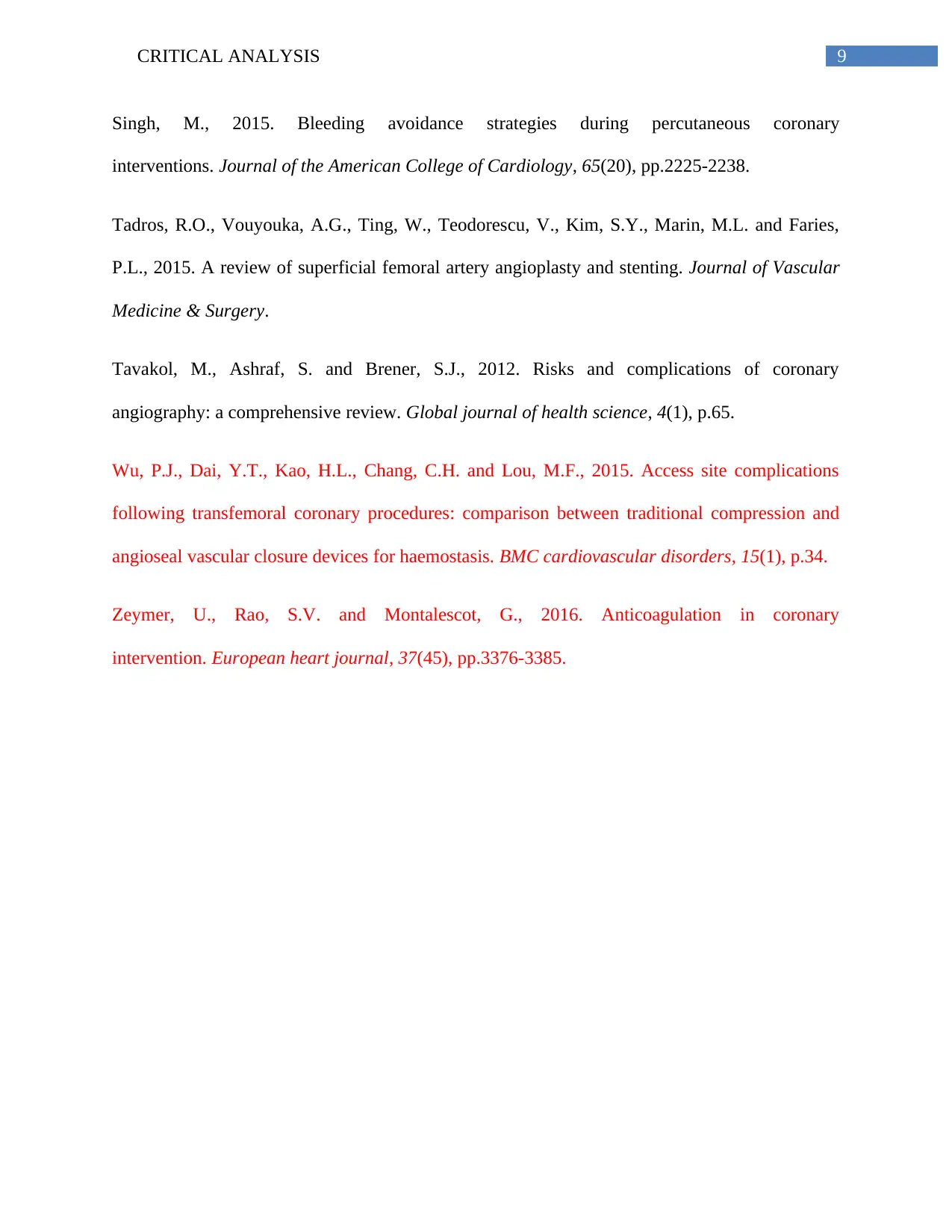
9CRITICAL ANALYSIS
Singh, M., 2015. Bleeding avoidance strategies during percutaneous coronary
interventions. Journal of the American College of Cardiology, 65(20), pp.2225-2238.
Tadros, R.O., Vouyouka, A.G., Ting, W., Teodorescu, V., Kim, S.Y., Marin, M.L. and Faries,
P.L., 2015. A review of superficial femoral artery angioplasty and stenting. Journal of Vascular
Medicine & Surgery.
Tavakol, M., Ashraf, S. and Brener, S.J., 2012. Risks and complications of coronary
angiography: a comprehensive review. Global journal of health science, 4(1), p.65.
Wu, P.J., Dai, Y.T., Kao, H.L., Chang, C.H. and Lou, M.F., 2015. Access site complications
following transfemoral coronary procedures: comparison between traditional compression and
angioseal vascular closure devices for haemostasis. BMC cardiovascular disorders, 15(1), p.34.
Zeymer, U., Rao, S.V. and Montalescot, G., 2016. Anticoagulation in coronary
intervention. European heart journal, 37(45), pp.3376-3385.
Singh, M., 2015. Bleeding avoidance strategies during percutaneous coronary
interventions. Journal of the American College of Cardiology, 65(20), pp.2225-2238.
Tadros, R.O., Vouyouka, A.G., Ting, W., Teodorescu, V., Kim, S.Y., Marin, M.L. and Faries,
P.L., 2015. A review of superficial femoral artery angioplasty and stenting. Journal of Vascular
Medicine & Surgery.
Tavakol, M., Ashraf, S. and Brener, S.J., 2012. Risks and complications of coronary
angiography: a comprehensive review. Global journal of health science, 4(1), p.65.
Wu, P.J., Dai, Y.T., Kao, H.L., Chang, C.H. and Lou, M.F., 2015. Access site complications
following transfemoral coronary procedures: comparison between traditional compression and
angioseal vascular closure devices for haemostasis. BMC cardiovascular disorders, 15(1), p.34.
Zeymer, U., Rao, S.V. and Montalescot, G., 2016. Anticoagulation in coronary
intervention. European heart journal, 37(45), pp.3376-3385.
1 out of 10
Related Documents
Your All-in-One AI-Powered Toolkit for Academic Success.
+13062052269
info@desklib.com
Available 24*7 on WhatsApp / Email
![[object Object]](/_next/static/media/star-bottom.7253800d.svg)
Unlock your academic potential
Copyright © 2020–2025 A2Z Services. All Rights Reserved. Developed and managed by ZUCOL.





